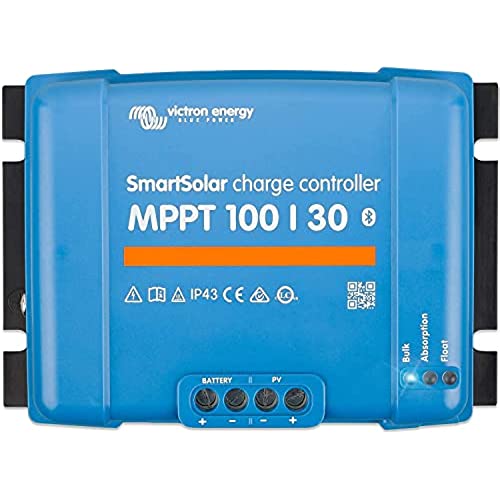
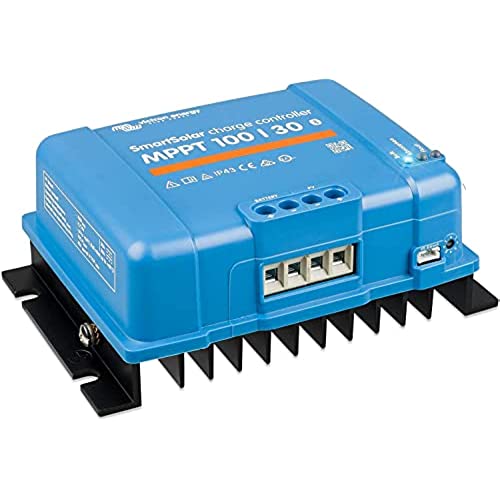
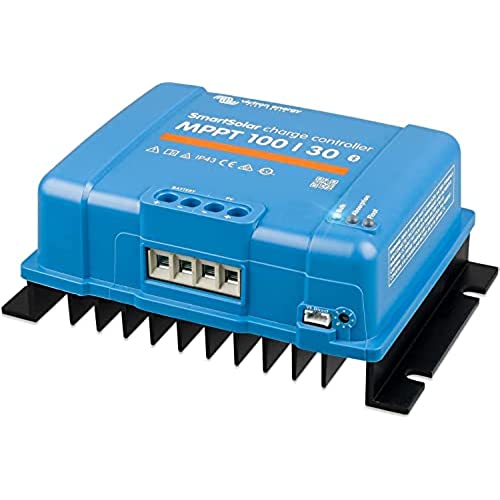
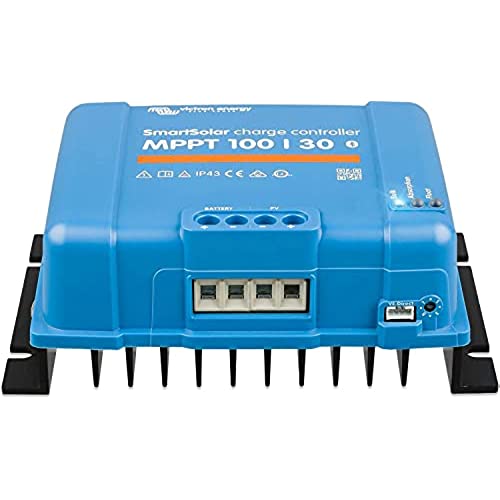
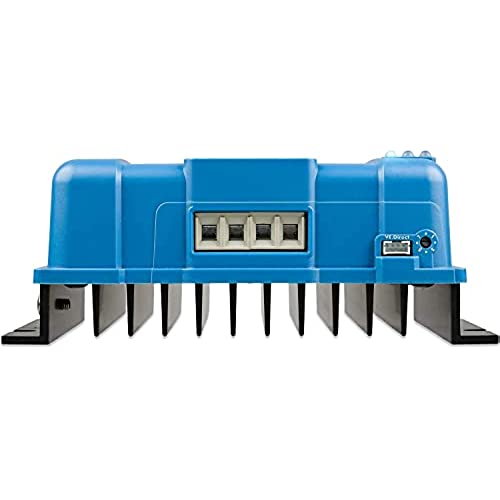





Victron Energy SmartSolar MPPT 100V 30 amp 12/24-Volt Solar Charge Controller (Bluetooth)
-

Tom
> 3 dayThe unit arrived on time and exactly what I wanted. It was easy to install and had it running within an hour (most of the time was making cables to connect to the battery and solar panels). I would highly recommend this unit with the BlueTooth interface to monitor the connection.
-

M. Dillon
> 3 dayThe 75-15 units work great and stay cool under full load. They work as advertised. That said, the 15A output limit doesnt give you much at 12V (200W) or 24V (400W) (my battery system is 24V LFP), and I made the mistake of undersizing the charge controller against my solar which runs 500W+ in full sun. Hence why I was able to make the comment about them staying cool under full load :-). So I recommend buying the SmartSolar MPPT 100-20 instead of the 75-15. The price point is still very good and those 5 extra amps can make a difference. Plus the 75-15 is limited to 24V battery systems while the 100-20 gives you the flexibility to move to a more powerful 48V battery system in the future. I also have two 100-20s. When maxed out at 20A they generally clock in at 60C and dont go much higher, so not as cool as the 75-15s. But the 100-20s are far more capable, and can handle 12/24/48V without issue. A low speed fan is all it takes to keep them in a nice comfort zone while pushing 20A to the battery. Im running 70V VOC and 80V VOC (roughly) strings with no issues into these controllers, so the input amps and losses are very low. Thus the charge controllers are limited only by the output amps. The control and programming features are great. Ive used the load output directly and the virtual load output (basically a relay control output) as well. There are a few quirks with the direct load output, it cant handle surges at all really, even short ones. The battery profile is completely customizable and output amps can be limited. I actually used one of my 75-15 charge controllers as a high-efficiency level shifter going from a 24V battery to a small 12V battery at one point using the customization to limit the current. -- It would be nice if the load output could handle more current and capacitive inflow currents on start. I have used the load output on 24V systems at around 15A without issue driving resistive loads. But just like the Victron battery-protect stuff, these FET-switched load outputs cheap-out on components and just arent very capable despite the rating. It would be nice if Victron could improve on them but I wont subtract a star since it isnt really the primary function for the charge controller and the virtual-load output works quite well. In fact, one can use the actual load output to switch certain other FET power switches, (or relays, or contactors) very quickly since they are capable of decent gate currents verses VE TX port. So there is versatility here that I like.
-

Sam Horowitz
> 3 dayI was using an EPEVER MPPT solar charge controller with similar specifications. OMG this controller is SO MUCH BETTER at calculating the maximum power point! In the last 5 days, Ive already generated HALF of what I generated with the EPEVER, which I had and used for 2 full months! Even in similar cloudy conditions I am generating so much more power! The built in Bluetooth function is super easy to set up. I used my android to configure it. I had it up and running in no joke, 5 minutes! I will CERTAINLY be buying more products from Victron!!
-

Marcos Estebez
> 3 dayIve had Epever and Renogy controllers which were both difficult to read and configure for Lithium battery. Once I resigned myself to bluetooth - I loved it! The software offers a lot of programmable options which is important for LifeP04 battery (check out Battle Born batteries for info on how to configure). The bad: Victron says to use 10AWG wires. Good luck. It took a half hour to install two cables. You install. You damage the wires. You cut. You reinstall and on and on...By the time I got both in, the terminal box was trashed and the screws (pleeeeease, my daughters Barbies jeep has sturdier screws..and theyre plastic) the screws have a very shallow indentation for a flathead screw driver. After multiple attempts of tightening, one of them was stripped. Ive ordered a 100/30 in the hopes of actually being able to use 10AWG. (Victron says that model accommodates 6AWG but reviewers disagree......) Disappointed but hopeful. If you are going to use this, go with 12AWG.
-

Repro63
> 3 dayI have built 3 so called Solar Generators, and have used Victron Energy charge controllers in all of them. I tried other brands, and always seemed to run into issues with configuration, ease of use and size. I have two 100/30 charge controllers and I love them both. They are small. very very efficient and they are so reliable. I love the Bluetooth connection and Victron Energys app. Configuration is a breeze, and I can even do a little logging of the chargers performance. This controller also has a very small footprint, and it fits into tight places. Installation is easy as well. These are little more expensive than other controllers, but they are worth it to me. They have never let me down, and they are very reliable. I find them to be a good value for the price and I highly recommend them. I give this controller 5 stars.
-

David D
> 3 dayThe terminals where the wires connect are tiny. My solar panels use 10 gauge wire which never in a million years would fit in the tiny connectors. The manual indicates that 10 gauge will work but I had to remove about half of the strands to get the wire in. I then bought some crimp on ferrules thinking that the 10 gauge ones would fit. Nope the 12 gauge tips barely worked. I hope that these tiny wires are enough for the power from the panels and into the inverter...
-

Alex
Greater than one weekI got this to upgrade older pwm controllers and most specifically for the data monitoring software. The data monitoring on this thing is great and one of the best out there for a small product like this. The fact it keeps track of energy production and battery condition is great. BUT the load controls setting for the load output terminals has been a nightmare to configure or get working properly. I got two of these and with the new software both do the same issue. Under custom settings the the load is supposed to be driven on and off by the battery voltage. How ever I have had issues where the load terminals never turn or when they do it doesnt turn the load off and completely drains the battery. I know that most people or applications dont use the load terminals and it doesnt affect there system. Mine is for a water pump so the load control was part of the buying decision. For now I have resorted to a different control.
-

aTypicalEngineer808
> 3 dayUpdate (2/12/23): Current inventory of VE products: (2) 100V/50A, (2) 100V/30A, (1) 100V/20A, (1) SmartShunt IP67 (newer), (1) SmartShunt (older), (1) BatterySense. Best feature is the VE.Smart networking feature, which allows the components to work together to optimize charging of the battery bank. Update (8/2/22): Ordered a 2nd unit. Working great! iPhone app has many great features. Summary: I have evaluated quite a few MPPT controllers for Vine, and while all were decent, the Victron Energy (VE) has high ratings, so I decided to purchase one for evaluation. My solar/PV system specs: 1000W of panels; 24-volt, 270Ah marine battery bank (Optima); Voltworks 2000W inverter. Using the system to reduce our electricity bill. This review is for the 100V/50A, which is the 2nd VE controller Ive purchased. Observations: The first thing to notice is that this one, unlike most others, does not have a control panel (just three LEDs); which means youll need a smart device to read the values. There are two basic VE offerings: this SmartSolar (built-in bluetooth), and BlueSolar (requires a BT dongle). Between the two, I went with the built-in BT (SmartSolar). One great feature of the VE system, is that it allows the MPPTs to communicate with each other via BT; which is a great feature for a larger system. Recommendations: One reason to choose the lower cost BlueSolar over the SmartSolar, is if you do not need the additional features that the BT brings; but for me, I didnt mind spending the extra $30-40 (per controller) to gain those features. Pros: Industrial quality & features; good application support (firmware updated upon first connect); security (bluetooth); good/efficient charging algorithm; good data and graphs. Cons: No built-in display (offset by the much better app and graphs). Conclusion: At $225, rating this 5-stars. Of all the MPPT controllers I have reviewed, Victron is the recommended brand. Related Products (lised in ORDER of HIGH to LOW rating): VICTRON ENERGY MPPT 100V 20 amp 12-24-Volt (Bluetooth) ~ $160 (5-star) https://www.amazon.com/gp/product/B075NPQHQK EPEVER MPPT Solar Charge Controller 10A 60V PV 1206N ~ $60 (5-star) https://www.amazon.com/gp/product/B094JCG6Y1 ACOPOWER Midas 40A MPPT ~ $180 (4-star) https://www.amazon.com/gp/product/B08HQB8RYK ACOPOWER MPPT Solar Charge Controller 30A ~ $140 (4-star) https://www.amazon.com/gp/product/B01NB1KOOZ Renogy Rover 20/30/40 Amp ~ $112/170/168 (2-star) https://www.amazon.com/gp/product/B01MRWTAB5
-

Cody Willey
Greater than one weekThese charge controllers are awesome. Im using 4 of them currently with the bmv712 shunt monitor and I love that they all connect via Bluetooth and share data. I love that the chargers synchronize to work with each other. The ability to check on your system and set your charge parameters from your phone is definitely worth it. The MPPT tracking is fast. Their efficiency is phenomenal. Being able to use the VE port as a relay controller rather than load terminals is preferred in my opinion for dump load options. However the app isnt as polished as the controllers themselves. Sometimes the Bluetooth is laggy and glitches. I wish the app showed a little more useful data that it is capable of showing, but it doesnt because if you buy all victron stuff a different product will show you. For example power being used. If the shunt monitor is showing how much power is going into the batteries and the charge controllers show your total network power, you can simply subtract the total power from battery power to show power consumption. Whats annoying is you must first select the charge controller, then it connects via Bluetooth to one single controller. You can only monitor one single device via Bluetooth at a time. It takes 10-30 seconds each time you select a device. This makes it difficult to compare data manually. Sure it shows your average discharge and deepest discharge, but if you dont check right before the sun comes up, theres no way to see what you used last night. No way to see how much power you used that day, week, etc... once again you could do it all manually. The app should just have a system overview showing all the data available and atleast a months worth of history. Or have the app store some data on your phone and synchronize every couple hours if your within range. I realize if you buy a Victron brand inverter or some other fancy expensive data logger it shows a lot of this data. I did not though. Its annoying when it is capable of showing data, but to really be able to use these devices to their potential you need to buy all Victron... I wish the programs for the relay function were a little more flexible. Great for most situations, but not the best. Maybe add some time delay options? Select sun up/down triggers along with voltage triggers. Temperature triggers would also be cool too. There stuff is good, but a some extra lines of code is all you need to make this stuff a little more friendly for the experimenters or budget conscious DIYers.
-

kwerks
> 3 dayI really expected to like the Victron Smart Solar. I already own the 100/15 Blue Solar plus bluetooth dongle, and have good results with it. However, after struggling with the Smart Solar I was disappointed and returned it. In my view its a step backward from Blue Solar. If youre thinking of buying the 75/15 Smart Solar, you may want to reconsider and get the 75/15 Blue Solar and buy the external bluetooth dongle. There is really no benefit to the Smart Solar over the Blue Solar + BT dongle. You might save $10-$20, but you end up with an inferior product in many other respects. First, the integrated bluetooth range is much less than the BT dongle. Were talking 5 feet vs. 20 to 30. This also gets to the heart of my main gripe: Victrons choice of Bluetooth transceiver. Theyre using newer BLuetooth Low Energy technology (BLE) vs older but more widely supported BT 4.0, as used in the external dongle. In my view it wasnt a good move. BLE, is not supported by the majority of BT enabled devices. If you want to use iOS or Android, be aware that even if they have BT, they will likely NOT work with the Smart Solar bluetooth! Obviously this isnt a good selling point and Victron sales literature doesnt warn customers about this ahead of time. Youll end up downloading their app and get frustrated trying to connect to the controller, and eventually learn that your 1 year old device wont work with it. Nearly every device in the world with BT will work with BT 4.0, but Victron went with the BT low energy and gave up compatibility with the majority of the worlds devices. Was that a smart decision? Well they saved a few cents per controller, and I suppose low energy in theory saves some power. But, the charge controller is NOT lacking for power. Its either getting power from a PV array or a presumably large battery, not a tiny batteries where BLE might be useful. I would much rather have 20-30 foot range and use a few more micro watts of power than need to stand 5 feet from the controller. And youll find with Android, that BLE *requires* that you enable location/GPS for the Victron Connect app to work! No kidding. Victron says they dont care about your location, and probably dont. But youll need to accept that and enable location services to use their app with Smart Solar. With Blue Solar and the external dongle its not necessary. This is forced on everyone by Google/Android not Victron, but again, the choice of using BLE was Victrons. Finally, IMO the 100/15 is better constructed than the 75/15, albeit at a higher price. The 100/15 has an external heat sink and the 75/15 does not. That could be a benefit in a hot environment like the desert. You may want to take a look at it. The next step up is 100/20 which also has an external heat sink like the 100/15. All of these have separate load terminals which is really useful because the controllers have a configurable low voltage disconnect (via the app) and can also track how much power the load is actually using. When you get over 20 amps, for example 100/30 amp controllers and up, they do not have separate load terminals. Update: I measured the current draw of a Blue Solar 100/15 and Smart Solar 100/20. Connected to battery at 12.8v. No PV or load connected, and not connected to app via BT. Blue Solar 100/15: 24 mA. With BT dongle 25.5-26 mA Smart Solar 100/20: 34 mA. With BT dongle 35-36.5 mA I dont have numbers for the 75/15, though its likely not more than above. The point is, the BT 4.x dongle takes only 1 to 1.5 mA. Unless youre using a 15 amp MPPT controller with a battery bank the size of a coin cell battery, the BT dongle is the way to go (IMO).
